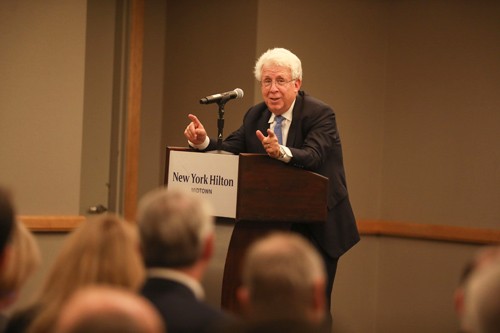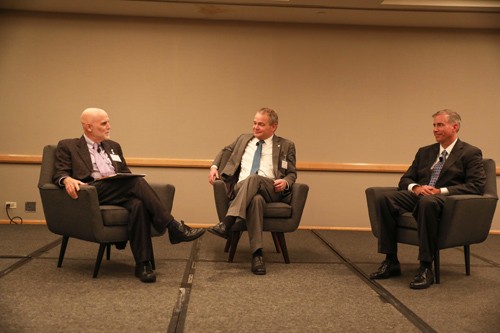The Trustees of the IFRS Foundation met in New York, US, on 15–17 October 2019. The meeting summary from the main meeting, as well as the agenda papers, meeting summary and an audio recording from the public meeting of the Trustees’ Due Process Oversight Committee are now available.
In conjunction with the meeting, the Trustees also hosted a stakeholder event jointly organised with CFA Institute. The focus of the event was how financial reporting can remain relevant in a changing world. Bob Pozen, senior lecturer at MIT Sloan, delivered the keynote speech, which was followed by a discussion between Chair of the International Accounting Standards Board Hans Hoogervorst and Chair of the US Financial Accounting Standards Board Russ Golden. Jason Zweig, a columnist at the Wall Street Journal, moderated the discussion and fielded questions from the audience. Read the article about the event below.
Standard-setters respond to investors’ changing needs
By Joseph Radigan, financial writer
Accounting standard-setters deal with a business world in constant flux. The use of non-GAAP measures is arguably the clearest reflection of the challenges involved with writing and maintaining accounting standards that properly reflect the economic reality.
Yet standard-setters themselves accept some responsibility for the growing prevalence of non-GAAP measures.
“One of the reasons why non-GAAP became so popular is that we ourselves have not provided much structure to the income statement,” International Accounting Standards Board (Board) Chair Hans Hoogervorst said at a 16 October 2019 stakeholder event in New York City, jointly organised by the IFRS Foundation and CFA Institute. IFRS Standards define revenue and profit or loss but not the subtotals that often sit between the income statement’s top line and bottom line. That left an opening for the companies to define their own performance measures to explain their performance. At the same time, securities analysts have been developing proprietary models using non-GAAP measures that they feel give them a view on a stock’s investment value.

Bob Pozen, a lecturer at the Massachusetts Institute of Technology’s Sloan School of Management, who was previously the chairman of MFS Investment Management, said too much credibility is given to the non-GAAP measures. Ultimately, they are performance indicators that are used to set compensation targets for senior executives. In Pozen’s view the Board’s plan to develop requirements for what it calls Management Performance Measures may lead to more discipline in the use of non-GAAP measures.
The Board hopes its Primary Financial Statements project will provide guidance for financial statements’ content and structure and provide clear definitions for terms like operating profit, and profits from investments and holdings in joint ventures and other associates. The introduction of more guidance for an income statement’s subtotals may leave businesses with less incentive to publicise non-GAAP measures.
“If the differences are not so big, then they might decide to forget about non-GAAP,” Hoogervorst said.
The reporting practices that distort financial statements are hardly limited to the use of non-GAAP measures. According to Hoogervorst, ‘other income’ and ‘other expenses’ are among the income statement categories that are often used with very little explanation about the items that are aggregated in them. According to Hoogervorst, income statement categories often used by companies with very little explanation about what it actually includes are those called ‘other income’ or ‘other expenses’, where there is far too much aggregation. Companies’ earnings can be lumped into this catchall category, which denies investors insight into the sources of a company’s income or the areas in which it is spending most of its money.
“That’s a source of frustration for many investors,” Hoogervorst said. He hopes the Primary Financial Statements project will result in more transparency both about non-GAAP and these ‘other’ items for investors.
The Board will publish its proposals in this area by the end of 2019.
The Board is also exploring whether to amend its approach to accounting for goodwill, but it is divided about the benefits of reintroducing goodwill amortisation to IFRS Standards. The Board plans to release a Discussion Paper in early 2020 for a 180-day comment period to weigh stakeholder interest in amending IFRS 3 Business Combinations and IAS 36 Impairment of Assets.

The Board hopes the feedback on the Discussion Paper will help it arrive at a consensus. Some Board members support a reintroduction of goodwill amortisation because they believe the existing impairment model is not providing information to the markets on a timely basis. Other Board members want to leave the impairment model intact because they believe the model, even with its limitations, still gives investors useful information that holds management accountable for its decisions about acquisitions.
“There should be an expense somewhere,” Hoogervorst said. “We see time and again that goodwill only gets written off when it’s too late.”
Hoogervorst acknowledged that the Board’s challenge is to provide investors with the information about acquisitions that they need.
Therefore, the Board’s project will not only deal with goodwill and how it is treated. It will also focus on possible new disclosures to help investors assess the subsequent performance of an acquisition.
The US Financial Accounting Standards Board (FASB) is also uncertain about how to resolve the questions about goodwill accounting in US GAAP. FASB Chair Russ Golden, who took part in the question-and-answer session with Hoogervorst, observed that while most of the FASB’s seven members want to reintroduce goodwill amortisation, they can’t agree on an approach. The FASB would like to keep US GAAP and IFRS Standards converged on goodwill accounting. But its plans are complicated by a desire among some US stakeholders to align the goodwill accounting for public companies, which aren’t allowed to amortise, with that for private companies, which gained the flexibility to amortise goodwill in Accounting Standards Update (ASU) No. 2014-02, Intangibles—Goodwill and Other (Topic 350): Accounting for Goodwill.
Golden said the FASB wants to hear from financial reporting professionals from outside the US during its deliberations so it can fully consider each approach.
